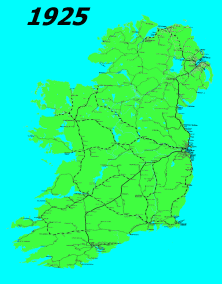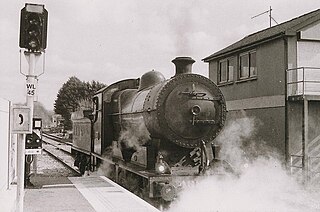
NI Railways, also known as Northern Ireland Railways, is the railway operator in Northern Ireland. NIR is a subsidiary of Translink, whose parent company is the Northern Ireland Transport Holding Company (NITHCo), and is one of eight publicly owned train operators in the United Kingdom, the others being Direct Rail Services, Northern Trains, Transport for Wales Rail, Southeastern, LNER, ScotRail, and TransPennine Express. It has a common Board of Management with the other two companies in the group, Ulsterbus and Metro.

The history of rail transport in Ireland began only a decade later than that of Great Britain. By its peak in 1920, Ireland had 3,500 route miles (5,630 km). The current status is less than half that amount, with a large unserviced area around the border area between Northern Ireland and The Republic of Ireland.

Rail transport in Ireland is provided by Iarnród Éireann in the Republic of Ireland and by Northern Ireland Railways in Northern Ireland.

The Ulster Transport Authority (UTA) ran rail and bus transport in Northern Ireland from 1948 until 1966.

The Northern Counties Committee (NCC) was a railway that served the north-east of Ireland. It was built to Irish gauge but later acquired a number of 914 mm narrow gauge lines. It had its origins in the Belfast and Ballymena Railway which opened to traffic on 11 April 1848.

The Great Northern Railway V class steam locomotives were 4-4-0 three-cylinder compound locomotives built in 1932 by Beyer, Peacock & Company for the Great Northern Railway (Ireland).

Belfast Lanyon Place is a railway station serving the city of Belfast in Northern Ireland. Located on Bridge Street in the Laganside area of central Belfast, it is one of four stations in the city centre, the others being Great Victoria Street, City Hospital and Botanic. Lanyon Place is the northern terminus of the cross-border Enterprise service to Dublin Connolly. It is also served by Northern Ireland Railways, which operates routes to other locations in Northern Ireland, including Derry, Bangor, Portadown and Larne.

The Great Northern Railway (Ireland) (GNR(I) or GNRI) was an Irish gauge (1,600 mm (5 ft 3 in)) railway company in Ireland. It was formed in 1876 by a merger of the Irish North Western Railway (INW), Northern Railway of Ireland, and Ulster Railway. The governments of Ireland and Northern Ireland jointly nationalised the company in 1953, and the company was liquidated in 1958: assets were split on national lines between the Ulster Transport Authority and Córas Iompair Éireann.

The Railway Preservation Society of Ireland (RPSI) is a railway preservation group founded in 1964 and operating throughout Ireland. Mainline steam train railtours are operated from Dublin, while short train rides are operated up and down the platform at Whitehead, County Antrim, and as of 2023, the group sometimes operates mainline trains in Northern Ireland using hired-in NIR diesel trains from Belfast. The RPSI has bases in Dublin and Whitehead, with the latter having a museum. The society owns heritage wagons, carriages, steam engines, diesel locomotives and metal-bodied carriages suitable for mainline use.

The NCC Class WT is a class of 2-6-4T steam locomotives built by the Northern Counties Committee's parent company, the London, Midland and Scottish Railway for service in Northern Ireland.

Lisburn railway station serves the city of Lisburn in County Antrim, Northern Ireland.

Londonderry Port and Harbour Commissioners (LPHC) No. 3 R H Smyth is a preserved Irish steam locomotive.

The Belfast–Newry line operates from Lanyon Place station in County Antrim to Newry in County Down, Northern Ireland. The manager for this line is based at Portadown railway station, although the line extends to the border to include the Scarva and Poyntzpass halts and Newry. Newry is on the fringe of the network, being the last stop before the border with the Republic of Ireland. The line follows the route of the northern half of the main Dublin–Belfast line, with the exception of calling at Belfast Great Victoria Street.

The Northern Counties Committee (NCC) Class U2 4-4-0 passenger steam locomotives consisted of 18 locomotives built for service in north-east Ireland. Ten of the engines were new builds supplied by the North British Locomotive Company (NBL) or constructed at the NCC's York Road works. The remainder were rebuilds of existing locomotives.

Greenisland railway station serves Greenisland in County Antrim, Northern Ireland. The station opened on 11 April 1848 as Carrickfergus Junction. It was renamed on 10 January 1893. The station used to be larger, with a third platform, but this was removed after the closure of the spur to the Derry~Londonderry Line. The station building is staffed from 7am to 3pm. A park and ride facility was built in 2009.

Botanic railway station serves the Botanic area in south Belfast, Northern Ireland and students for Queen's University Belfast; it is also near Shaftesbury Square which is along Botanic Avenue. It is named after the nearby Belfast Botanic Gardens. It is one of the four stations located in the city centre, the others being City Hospital, Great Victoria Street, and Lanyon Place.

The SLNCR Lough Class was a class of 0-6-4T steam tank locomotives of the Sligo, Leitrim and Northern Counties Railway (SLNCR).

The Dublin and South Eastern Railway 15 and 16 were a pair of 2-6-0 steam locomotives which were built for the heavy goods (freight) traffic on the Dublin to Wexford main line of the Dublin and South Eastern Railway (DSER). The two locomotives were built by Beyer, Peacock and Company at their Gorton Foundry in Manchester.

The Great Northern Railway (Ireland) class S was a class of five 4-4-0 steam locomotive that the Great Northern Railway introduced in 1913 to haul Belfast – Dublin express passenger trains. They were followed two years later by the three similar class S2 locomotives.

Great Victoria Street is a railway station serving the city centre of Belfast, Northern Ireland. It is one of two major stations in the city, along with Lanyon Place, and is one of the four stations located in the city centre, the others being Lanyon Place, Botanic and City Hospital. It is situated near Great Victoria Street, one of Belfast's premier commercial zones, and Sandy Row. It is also in a more central position than Lanyon Place, with the Europa Hotel, Grand Opera House and The Crown Liquor Saloon all nearby.





















